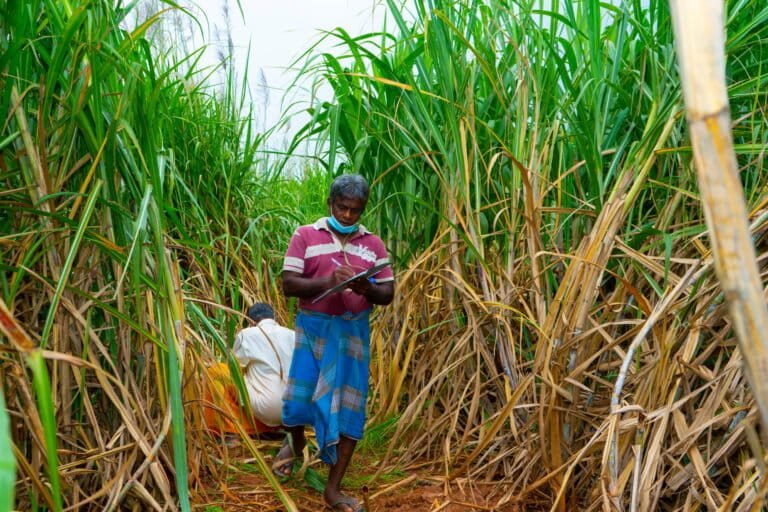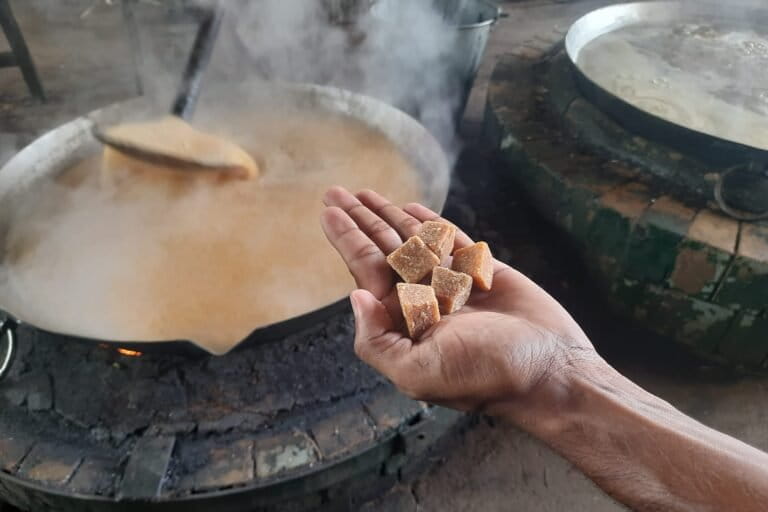- After 20 years of research, the Sugarcane Research Institute (SRI) of Sri Lanka has introduced four new varieties with improved sugar recovery percentages, cane yield and disease resistance.
- An interactive mobile app called Uksaviya has been introduced to assist sugar cane farmers in disease identification, cultivation advice and access to the latest knowledge.
- An institutional business framework too has been developed linking researchers and industry to improve collaboration, precision, and commercialization of cutting-edge research.
- With Sri Lanka’s agriculture hit by multiple issues, SRI’s efforts offer some hope.
COLOMBO — Sri Lanka is a nation where agriculture is a pivotal factor of the country’s economy. However, the past two years were bleak for the agriculture sector following the government’s agrochemical importation ban in April 2021, triggering a severe economic and food crisis. Although the financial nosedive also impacted scientific research and development, Sri Lankan agronomists have been working to improve the situation and restore agriculture.
Bringing such efforts to fruition, agronomists at the Sri Lanka Sugarcane Research Institute (SRI) presented a sweet treat to the nation in July 2023. They introduced four new improved cultivars of sugar cane (Saccharum officinarum) along with some technological and policy innovations linking researchers, farmers, and industry. Working in a highly challenging environment, researchers at SRI developed these new sugar cane varieties that promise increased productivity, offering some hope. The new varieties were created through crossbreeding in field experiments.

Sweetening the pot for farmers, they also developed an app called Uksaviya (translating to “strength of sugar cane”). The first of its kind to be introduced by an agricultural research institute in Sri Lanka, the app can help farmers identify diseases and apply effective cultivation methods and find relevant current study results. The institute has been catering to technological and technical requirements of the industry since 1981.
Established as a commercial cultivation in the late 1950s, sugar cane is a multipurpose crop, mainly used for sugar, ethanol, and biofuel production in Sri Lanka. However, only 15% of the national sugar requirement is fulfilled by local production, compelling the country to import sugar at a high cost. SRI’s crop physiology experts and sugar manufacturers say that a major hurdle is the sugar recovery percentage of the sugar cane variety routinely grown in Sri Lanka being as low as 6-8%, according to SRI data. Comparatively, varieties grown in top sugar cane-growing countries have a sugar recovery percentage as high as 15%.

Low recovery percentage
Narrowing this gap, the four newly introduced varieties have an improved sugar recovery percentage of about 10-13%, according to SRI data.
Gamini Ratnayake, chief executive officer of Ethimale Plantation Private Ltd., a leading sugar factory in the country, told Mongabay that improved sugar recovery percentage is a major achievement the industry has been seeking in cultivars. As farmers get paid for the weight of cane harvested, they mostly prefer varieties that give a higher cane yield.
However, the low sugar recovery percentage of currently grown varieties makes it less profitable for the factories. Ratnayake says the new varieties having improved sugar recovery with high cane yield is a step toward a win-win for both sugar cane growers and sugar manufacturers.

“These new varieties increase the productivity of the country’s sugar cane cultivation on several levels,” said Janendra De Costa, crop physiologist and a professor of crop science at the University of Peradeniya, who was not involved in the research. The new varieties have better ratoonability, the agricultural practice of having two harvests during one cropping season, allowing farmers to re-grow crops from the stubble remaining after harvesting the first.
Three out of the four varieties have high productivity under rainfed conditions, suggesting their improved drought tolerance. These are features that would improve cost efficiency for farmers in terms of replanting and irrigation, Costa told Mongabay.

Bringing these improved varieties into light was a lengthy process. Malika Perera, head of the crop improvements section at SRI, said it usually takes more than 15 years to introduce a new sugar cane variety to the market, given the long life cycle of sugar cane and the rigorous testing procedures done in their field and on factory performance for disease resistance. The four new varieties are the result of experiments since 2003.
Perera, a senior scientist in Udawalawa, in Sri Lanka’s deep south, told Mongabay: “The onset of COVID-19 and the economic crisis that followed presented challenges with industry testing, travel restrictions and manpower shortages. Nevertheless, with the resources and expertise available to us, we are continuing our research on testing new cultivars, with more varieties lined up to be introduced soon, which we hope to recommend to other sugar cane-growing countries in the region as well.”

High level of disease resistance
These varieties also promise resistance to sugar cane smut disease and leaf scald disease and tolerance to white leaf disease, experts say. Sumedha Thushari, a pathologist at SRI’s division of crop protection said: “It is a tricky procedure to isolate varieties which are both disease tolerant and high yielding. Introducing varieties in that sweet spot is a collaborative effort of all research divisions and the industry.”
Thushari, who is currently working on a Ph.D. in sugar cane pathology, said that according to ongoing research, there is a possibility of introducing resistant varieties in the future by selectively breeding from resistant parental varieties.

Meanwhile, the new app, Uksaviya, was designed to aid farmers in identification and management of common diseases. Its creator, Lahiru Kumarasiri, is a young scientist, enthusiastic about amalgamating agriculture with the latest trends in information technology, and Uksaviya is the outcome of the work-from-home period of 2021.
“This mobile app involves the development of an expert system for disease and nutrient deficiency detection based on expert knowledge of experienced farmers as well as subject specialists,” Kumarasiri told Mongabay. “That expert system is integrated into a software, which can reason and diagnose diseases and nutrient deficiencies. This way, the knowledge and reasoning ability limited to only a few becomes available to a wider audience at their fingertips,” he said.
Uksaviya also includes advice on land preparation, cultivation methods, fertilization, and sugar cane-based products, as well as the latest research findings. Lahiru said Uksaviya mainly targets the young generation of farmers. He said he believes that at a time when most young farmers are abandoning sugar cane cultivation and seeking other professions, integrating these kinds of modern technologies into their farming culture would encourage them to remain in the industry and reap the benefits of the latest findings through efficient knowledge exchange.

Applying new methods
Thilanka Ariyawansha, a member of the research team, is keen to apply new methods to achieve maximum benefits out of the research effort. Having recently completed his Ph.D. at the University of Tsukuba, Japan, Ariyawansha was inspired to adapt the research policies he absorbed while in Japan.
He got an ideal opportunity to execute that vision when the National Innovation Agency (NIA) collaborated with SRI to restructure its research policy.
Ariyawansha told Mongabay: “We created a business link with a framework where the sugar cane industry can request research that they find necessary. Institutional researchers can combine their ideas and expertise with those requests and carry out precise research that solves existing problems.”
Ariyawansha said this facilitates institutional researchers to propose their research ideas to the industry and assess its commercial relevance. This improves precision of research while ensuring the proper distribution of benefits among all parties involved in the research and the protection of intellectual property rights. Further, resources could be allocated for research with pressing industrial needs while researchers also get commercial benefits for their work.

Vindya Wijesinghe, a senior innovations officer for tech transfer at the NIA said, “Implementing frameworks of this sort completes the triple helix of technology transfer in Sri Lanka — universities, research institutes and industry. Through this, research and technology generated in universities and research institutes is seamlessly transferred to the industry.”
“We have a strong team of researchers, who are enthusiastic and committed to make a change in Sri Lankan agriculture, despite the limited resources and being based in remote Udawalawa” said M.S. Perera, the director at SRI.
Banner image: A farmer holding freshly harvested sugarcane in his hands. Image courtesy of the Sugarcane Research Institute, Sri Lanka.
Author Manasee Weerathunga is a Sri Lankan freelance science journalist, currently pursuing her Ph.D. in the Department of Biology, University of Florida. Manasee is enthusiastic about topics related to diversity, inclusivity, equity and accessibility in science and research in the Global South.
Citations:
Cursi, D.E., Hoffmann, H.P., Barbosa, G.V.S. et al. History and Current Status of Sugarcane Breeding, Germplasm Development and Molecular Genetics in Brazil. SugarTech 24, 112–133 (2022). https://doi.org/10.1007/s12355-021-00951-1
C.S. Weeraratna and P.A. Weerasinghe (2011). Agriculture of Sri Lanka. Dehiwala: C.S. Weeraratna. pp. 9–10
Deegala, D.M.B.M., Abeysingha, N.S., Muthuwatta, L.P. et al. Sustainable Growing Areas for Sugarcane in Sri Lanka Under a Changing Climate. SugarTech 24, 1801–1813 (2022). https://doi.org/10.1007/s12355-022-01155-x
